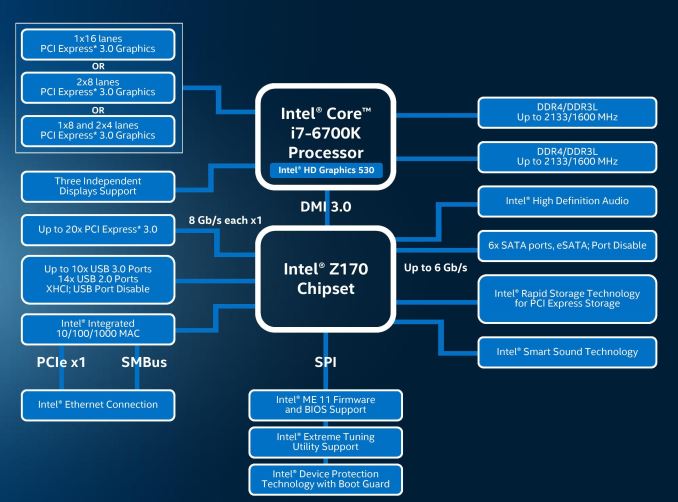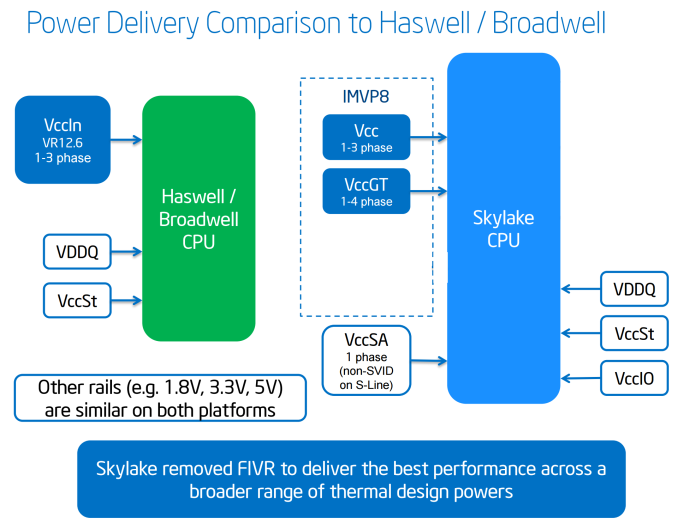The Intel 6th Gen Skylake Review: Core i7-6700K and i5-6600K Tested
by Ian Cutress on August 5, 2015 8:00 AM ESTThe Skylake CPU Architecture
As with any new Intel architecture, the devil is in the details. Previously at AnandTech we have been able to provide deep dives into what exactly is going on in the belly of the beast, although the launch of Skylake has posed a fair share of problems.
Nominally we rely on a certain amount of openness from the processor/SoC manufacturer in providing low level details that we can verify and/or explain. In the past, this information has typically been provided in advance of the launch by way of several meetings/consultations with discussions talking to the engineers. There are some things we can probe, but others are like a black box. The black box nature of some elements, such as Qualcomm’s Adreno graphics, means that it will remain a mystery until Pandora’s box is opened.
In the lead up to the launch of Intel’s Skylake platform, architecture details have been both thin on the ground and thin in the air, even when it comes down to fundamental details about the EU counts of the integrated graphics, or explanations regarding the change in processor naming scheme. In almost all circumstances, we’ve been told to wait until Intel’s Developer Forum in mid-August for the main reason that the launch today is not the full stack Skylake launch, which will take place later in the quarter. Both Ryan and I will be at IDF taking fastidious notes and asking questions for everyone, but at this point in time a good portion of our analysis comes from information provided by sources other than Intel, and while we trust it, we can't fully verify it as we normally would.
As a result, the details on the following few pages have been formed through investigation, discussion and collaboration outside the normal channels, and may be updated as more information is discovered or confirmed. Some of this information is mirrored in our other coverage in order to offer a complete picture in each article as well. After IDF we plan to put together a more detailed architecture piece as a fundamental block in analyzing our end results.
The CPU
As bad as it sounds, the best image of the underlying processor architecture is the block diagram:
From a CPU connectivity standpoint, we discussed the DDR3L/DDR4 dual memory controller design on the previous page so we won’t go over it again here. On the PCI-Express Graphics allocation side, the Skylake processors will have sixteen PCIe 3.0 lanes to use for directly attached devices to the processor, similar to Intel's previous generation processors. These can be split into a single PCIe 3.0 x16, x8/x8 or x8/x4/x4 with basic motherboard design. (Note that this is different to early reports of Skylake having 20 PCIe 3.0 lanes for GPUs. It does not.)
With this, SLI will work up to x8/x8. If a motherboard supports x8/x4/x4 and a PCIe card is placed into that bottom slot, SLI will not work because only one GPU will have eight lanes. NVIDIA requires a minimum of PCIe x8 in order to enable SLI. Crossfire has no such limitation, which makes the possible configurations interesting. Below we discuss that the chipset has 20 (!) PCIe 3.0 lanes to use in five sets of four lanes, and these could be used for graphics cards as well. That means a motherboard can support x8/x8 from the CPU and PCIe 3.0 x4 from the chipset and end up with either dual-SLI or tri-CFX enabled when all the slots are populated.
DMI 3.0
The processor is connected to the chipset by the four-lane DMI 3.0 interface. The DMI 3.0 protocol is an upgrade over the previous generation which used DMI 2.0 – this upgrade boosts the speed from 5.0 GT/s (2GB/sec) to 8.0 GT/s (~3.93GB/sec), essentially upgrading DMI from PCIe 2 to PCIe 3, but requires the motherboard traces between the CPU and chipset to be shorter (7 inches rather than 8 inches) in order to maintain signal speed and integrity. This also allows one of the biggest upgrades to the system, chipset connectivity, as shown below in the HSIO section.
CPU Power Arrangements
Moving on to power arrangements, with Skylake the situation changes as compared to Haswell. Prior to Haswell, voltage regulation was performed by the motherboard and the right voltages were then put into the processor. This was deemed inefficient for power consumption, and for the Haswell/Broadwell processors Intel decided to create a fully integrated voltage regulator (FIVR) in order to reduce motherboard cost and reduce power consumption. This had an unintended side-effect – while it was more efficient (good for mobile platforms), it also acted as a source of heat generation inside the CPU with high frequencies. As a result, overclocking was limited by temperatures and the quality of the FIVR led to a large variation in results. For Skylake on the desktop, the voltage regulation is moved back into the hands of the motherboard manufacturers. This should allow for cooler processors depending on how the silicon works, but it will result in slightly more expensive motherboards.
A slight indication of this will be that some motherboards will go back to having a large amount of multiplexed phases on the motherboard, and it will allow some manufacturers to use this as a differentiating point, although the usefulness of such a design is sometimes questionable.












477 Comments
View All Comments
extide - Monday, August 10, 2015 - link
Yeah, it's right there -- the Y variant is Core M Skylake.jeffkibuule - Thursday, August 6, 2015 - link
milkod2001 wants the quad-core H SKU (45-55W) in a chassis of a laptop designed for a dual-core U SKU (15-28W). That's not going to go over so well.extide - Monday, August 10, 2015 - link
Well we had a 35w Quad core all the way back with Ivy Bridge, doesnt seem to me to be at all un-reasonable to see a 28w quad core, it definitely seems technically feasible, at least.HardwareDufus - Wednesday, August 5, 2015 - link
Using an IvyBridge, 3770k at 4ghz. Still feeling very up to date.Guess I'll look at Kaby Lake next year if they have something like an unlocked I7-7775k that includes GT4e. I'd like to see the GT4e support multiple DisplayPort/HDMI and ditch DVI-D.
Teknobug - Wednesday, August 5, 2015 - link
I had to sell my i7 3770K to pay bills (and pay U-Haul for moving), what a great system it was but I'm using an i5 3550 and it still holds up.StrangerGuy - Wednesday, August 5, 2015 - link
"I’d love to see an i3 part in the future, but I suspect we will have to wait and see if Intel gets serious competition again"Knowing Intel's usual market segmentation games, it will be an unlocked i3 2C/4T that will be priced so close to the cheapest i5 quad it makes the next to completely pointless.
Teknobug - Wednesday, August 5, 2015 - link
Yup I'm more interested in i3's these days ever since Haswell ones with pretty good perf/cost, but if it's going to be priced like the i3 43xx to a i5 4440 then forget it. lolextide - Monday, August 10, 2015 - link
We might still be able to overclock the i3's using the BCLK. I hope they keep the BCLK separate in all models, not just K series.joex4444 - Wednesday, August 5, 2015 - link
On RAM latency and "performance index," I'm running dual channel DDR2-1000 CAS5, which has a 2ns clock time -- quite large relative to DDR3-1866 (1.07ns) or DDR4-2400 (0.83ns). At CAS5, the true latency is 10ns, slightly worse than DDR3-1866 CAS9 (9.65ns) and slightly better than DDR3-1866 CAS10 (10.72ns). DDR4-2400 CAS15 yields 12.5ns - a full 25% slower than DDR2-1000 CAS5.Now for the "performance index" mentioned - DDR2-1000 CAS5 has a PI of 200 (1000/5). Compare to DDR3-1866 CAS9 (207), DDR3-1866 CAS10 (187), or DDR4-2400 CAS15 (160) and this 6-year old RAM looks fairly modern.
Yet the bandwidth one gets from DDR2-1000 CAS5 is in the handful of GB/s, while DDR4 on Skylake is in the 25-30GB/s range...
extide - Monday, August 10, 2015 - link
Granted, what you said is correct, but remember that DDR2-1000 CAS5 was significantly faster than most people were running DDR2.